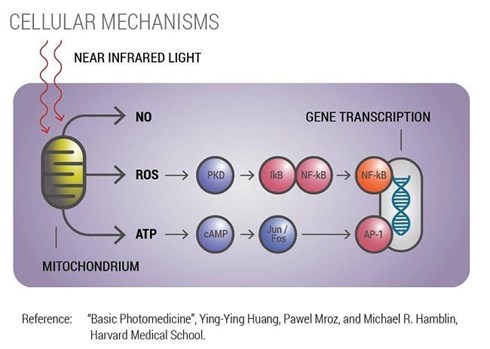 MechanismsWhat Is Low Intensity Laser Therapy?Laser therapy is the medical use of monochromatic light from a low intensity laser diode (250 milliwatts or less) or an array of high intensity super luminous diodes (providing total optical power up to the 2000 milliwatt range). Conditions successfully treated by laser light include painful inflammatory joint and muscle conditions such as tendonitis and osteoarthritis, particularly of the neck, knee and shoulder and back. Many sports injuries and certain skin diseases respond too. Recently the beneficial effects of low intensity laser are being shown in deep inflammatory conditions such as endometriosis, pelvic inflammatory disease, ulcerative colitis and inflammation of the prostate. The light source is placed in contact with the skin allowing the photon energy to penetrate tissue, where it interacts with various intracellular biomolecules resulting in biochemical changes in deep cellular components, such as mitochondria – the “power plants” of the cell. Many of the body's healing processes are accelerated or enhanced. The TechnologyThis relatively new technology bathes normal and abnormal tissue with photons. Photons are particles of light energy that are absorbed by a variety of micro-molecules within the cell, a process that initiates a number of physiological responses. In irradiated cells light energy is converted into biochemical energy, stimulating cellular respiration and regeneration. The result: cell structure and function are restored using the body’s own mechanisms. The monochromatic coherent and polarised characteristics of the therapeutic light beam permit penetration of deep tissues without harming normal cells. It should be noted that the end result is intending to be curative, rather than just symptom control - (the conventional approach for the management of pain). The Advantages Of Low Intensity Laser Therapy- Non-invasive
- Non-toxic
- Easily tolerated
- Highly effective
- Minimal negative side effects
The Physiological Effects Of Low Intensity Laser TherapyShort Term Effects- Production and release of beta-endorphins (these are morphine like substances produced by various cells in the body that inhibit the sensation of pain).
- Cortisol production is increased (cortisol is the precursor of cortisone). This enables the body to combat the stress associated with trauma or the disease process.
- The short-term effect is significant in 5-10% of cases during or after the conclusion of the initial treatment, but is not as important as the long term or cumulative effect.
Long Term Or Cumulative Effects- ATP (adenosine triphosphate) production is increased resulting in improved cellular metabolism.
- DNA (deoxyribonucleicacid) production; the protein building block of tissue is substantially increased.
- Neurotransmission is facilitated due to elevated levels of serotonin and aceytylcholine.
- Mitochondrial activity is stimulated resulting in cell replication etc. (i.e. replacement, regeneration and repair of abnormal cells)
- Modulation of macrophages, fibroblasts and other cells.
- Angiogenesis (formation of new blood vessels).
- Regulates cell membrane potential, essential in Na, Cl and K ion transfer (electrolyte balance).
- Cytokines and other chemicals enhancing cellular communication are released.
Other Effects- The immune response is stimulated
- Lymphatic drainage is enhanced
- The histamine response is modified
- Production of growth factors is increased
- The body's healing processes are accelerated
These beneficial physiological changes are the result of cell stimulation and tissue regeneration. Other positive effects are found including hormonal change and alterations to cerebral spinal fluid. These are significant and are currently under investigation. Dr Peter J Herbert 2018 |